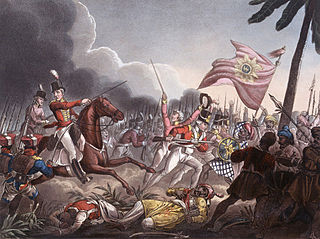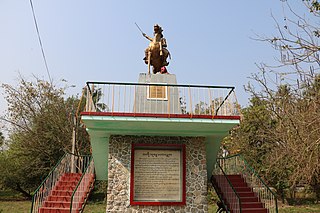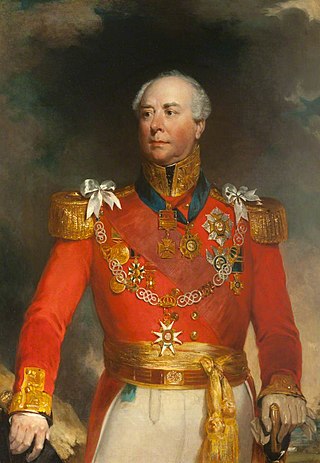
The First Anglo-Burmese War, also known as the First Burma War, was the first of three wars fought between the British and Burmese empires in the 19th century. The war, which began primarily over the control of what is now Northeastern India, ended in a decisive British victory, giving the British total control of Assam, Manipur, Cachar and Jaintia as well as Arakan Province and Tenasserim. The Burmese submitted to a British demand to pay an indemnity of one million pounds sterling, and signed a commercial treaty.

The Indian Army during World War II, a British force also referred to as the British Indian Army, began the war, in 1939, numbering just under 200,000 men. By the end of the war, it had become the largest volunteer army in history, rising to over 2.5 million men in August 1945. Serving in divisions of infantry, armour and a fledgling airborne force, they fought on three continents in Africa, Europe and Asia.

The Battle of Assaye was a major battle of the Second Anglo-Maratha War fought between the Maratha Empire and the British East India Company. It occurred on 23 September 1803 near Assaye in western India. An outnumbered Indian and British force, under the command of Major General Arthur Wellesley, defeated the combined Maratha army of Daulatrao Scindia and the Bhonsle Raja of Berar. The battle was Wellesley's first major victory and the one he later described as his finest accomplishment on the battlefield, even more so than his more famous victories in the Peninsular War, and his defeat of Napoleon Bonaparte at the Battle of Waterloo.
The 89th Regiment of Foot was a regiment of the British Army, raised on 3 December 1793. Under the Childers Reforms the regiment amalgamated with the 87th Regiment of Foot to form the Princess Victoria's in 1881.

The Battle of Sobraon was fought on 10 February 1846, between the forces of the East India Company and the Sikh Khalsa Army, the army of the Sikh Empire of the Punjab. The Sikhs were completely defeated, making this the decisive battle of the First Anglo-Sikh War.
The battle of Prome was a land-based battle between the Kingdom of Burma and the British Empire that took place near the city of Prome, modern day Pyay, in 1825 as part of the First Anglo-Burmese War. It was the last-ditch effort by the Burmese to drive out the British from Lower Burma. The poorly equipped Burmese army despite the advantage in numbers suffered a defeat. The British army's subsequent march toward north threatened Ava, which led to peace negotiation by the Kingdom of Burma.
Myawaddy Mingyi U Sa was a Konbaung-era Burmese poet, composer, playwright, general and statesman. In a royal service career that spanned over six decades, the Lord of Myawaddy served under four kings in various capacities, and was a longtime secretary to King Bagyidaw. Multi-talented Sa is best remembered for his innovative contributions to classical Burmese music and drama, as well as for his brilliant military service.

General Maha Bandula was commander-in-chief of the Royal Burmese Armed Forces from 1821 until his death in 1825 in the First Anglo-Burmese War. Bandula was a key figure in the Konbaung dynasty's policy of expansionism in Manipur and Assam that ultimately resulted in the war and the beginning of the downfall of the dynasty. Nonetheless, the general, who died in action, is celebrated as a national hero by the Burmese for his resistance to the British. Today, some of the most prominent places in the country are named after him.

The Indian Army, also called the British Indian Army, was involved in World War I as part of the British Empire. Over one million Indian troops served overseas, of whom 62,000 died and another 67,000 were wounded. In total at least 74,187 Indian soldiers died during the war.

Danuphyu Township is a township of Maubin District in the Ayeyarwady Region of Burma (Myanmar). Danubyu Township is known as the death place of the general Maha Bandula at Danubyu Fort effectively ending the First Anglo-Burmese War by forcing the Burmese to surrender to the British.
Danubyu is a town in the Ayeyarwady Division of south-west Myanmar, located on the west bank of the Ayeyarwady River in the Ayeyarwady Delta. It is the seat of the Danubyu Township in the Maubin District.

The 16th Light Cavalry is a regiment of the Armoured Corps, a primary combat arm of the Indian Army. Prior to India gaining independence from the British in 1947, it was a regular cavalry regiment of the British Indian Army. It was formed in 1776 and is the oldest armoured regiment raised in India. The 16th Light Cavalry saw service in a number of conflicts ranging from the Second Anglo-Mysore War in 1781 to World War II. It has a number of battle honours including "Punjab 1965" earned during the Indo-Pakistani War of 1965.

Sitabuldi Fort, site of the Battle of Sitabuldi in 1817, is located atop a hillock in central Nagpur, Maharashtra, India. The fort was built by the British after they won this area following the battle of Sitabuldi. After winning the battles of Sitaburdi, Sakkardara and Nagpur Richard Jenkins allowed Mudhoji II Senasaheb Subha to continue to rule to Nagpur and entered into a treaty with him on 6th January 1818 which wasratified later by Governor General. The article 7 of the treaty stated ‘The two hills of Seetabuldee with the bazaars and land adjoining, to a distance to be hereafter specified, shall be henceforth included in the British boundary, and such Military works erected as may be deemed necessary.’ By this treaty the British occupied the Sitaburdi hills and large areas on all four sides. However no major construction work was erected on it for next two years. The area surrounding the hillock, now known as Sitabuldi, is an important commercial hub for Nagpur. To the south is Nagpur Railway Station and behind it is Tekdi Ganapati, a temple of Ganesha. The fort was a home to the Indian Army's 118th infantry battalion Grenadiers till 2019.
Maha Ne Myo was a Burmese general in the royal service of King Bagyidaw of Konbaung dynasty. In the First Anglo-Burmese War, Maha Ne Myo led the Burmese forces after the death of Gen. Maha Bandula in April 1825 until his own death in the battle of Prome on 2 December 1825. His death effectively ended any expectations the Burmese had of driving out the British, and was followed by the Treaty of Yandabo in February 1826 that ended the war strictly on British terms.

The Battle of Buffalo took place during the War of 1812 on December 30, 1813, in the State of New York, near the Niagara River. The British forces drove off the American defenders and destroyed many buildings and ships. The operation was retaliation for American troops burning the Canadian village of Newark.

General Sir Archibald Campbell, 1st Baronet was a Scottish soldier who served as an officer in the British Army. From 1824 to 1826, Gen. Campbell commanded the British forces in the First Anglo-Burmese War, the longest and most expensive war in British Indian history, that gave the British control of Assam, Manipur, Cachar, Jaintia, Arakan and Tenasserim. He became known as the "Hero of Ava". From 1831 to 1837, he was the administrator of the colony of New Brunswick, Canada. The Canadian city of Campbellton in the province of New Brunswick was named in his honour.

The Royal Armed Forces were the armed forces of the Burmese monarchy from the 9th to 19th centuries. It refers to the military forces of the Pagan Kingdom, the Kingdom of Ava, the Hanthawaddy Kingdom, the Toungoo dynasty and the Konbaung dynasty in chronological order. The army was one of the major armed forces of Southeast Asia until it was defeated by the British over a six-decade span in the 19th century.
The Battle of Ramu, fought in May 1824, was one of the opening battles of the First Anglo-Burmese War. On May 10, 1824, the Burmese under General Maha Bandula launched an invasion of Chittagong from Arakan as the southern part of a two-pronged attack aimed at Calcutta. They offered to end the invasion if the British were to hand over some Arakanese rebels that had taken refuge in the Bengal Presidency. The British commander at Ramu, Captain Noton, rejected the offer, and the Burmese detachment under Lord Myawaddy Mingyi U Sa attacked. After three days of fighting the British troops, a mixed force with a total strength of several hundred men, was routed and forced from Ramu on May 17. The British losses in killed, wounded and missing amounted to more than half the strength of the garrison. The Burmese however failed to exploit their advantage, and Maha Bandula's army would withdraw to counter the British occupation of Rangoon.

Fort Siallum, is a defensive fort in Chin State, Myanmar, built during the British annexation of Chin Hills, Myanmar. The fort was built by the Chin (Sizang) in the year of 1889 and located near Voklak village in Tedim Township, Myanmar.
Lieutenant-general Sir John Doveton was a British military officer in the East India Company's Madras Army.













